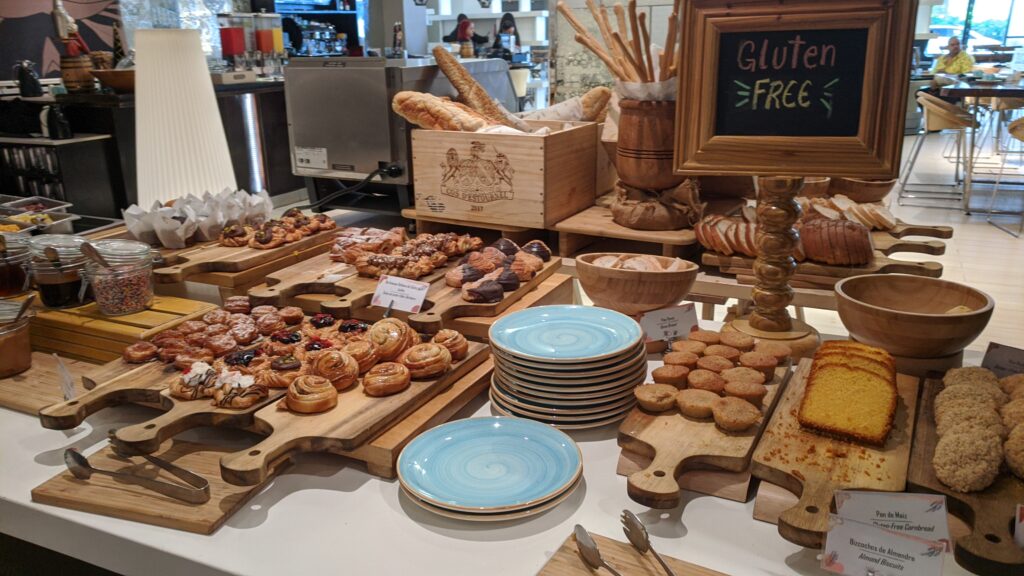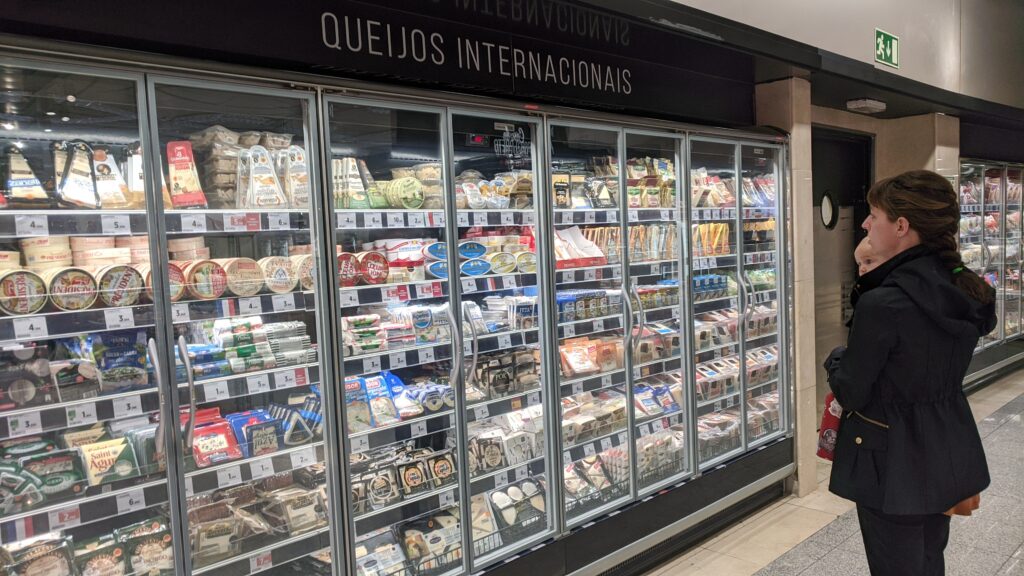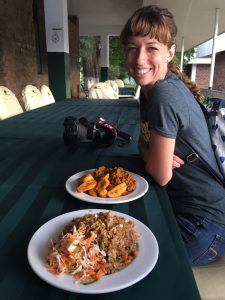We love food.
We especially love food that has variety and unique flavours.
But more than food, we love to save money. Food, unfortunately, is a great way to waste a lot of money if you aren’t careful.
According to a conglomeration of sources, the average monthly food expenses for a family of four in the US can range from $600-1,000.
Honestly, we don’t know how they do it.
 We live in the Minneapolis, MN, area, have one toddler and one infant, and average about $220 or less per month between groceries and restaurants. Sadly, we even have food go bad because we cannot keep up with all the food that we have. We truly are blessed beyond measure.
We live in the Minneapolis, MN, area, have one toddler and one infant, and average about $220 or less per month between groceries and restaurants. Sadly, we even have food go bad because we cannot keep up with all the food that we have. We truly are blessed beyond measure.
When we travel, our eating habits don’t change too much as we bring along our own food with us whenever we can to avoid paying for food at restaurants. If we are on longer trips where we stay in hotels or Airbnbs and cannot bring enough of our own food with us, we will buy food locally and prepare our own meals.
Yes, from time to time we might miss out on local cuisine, especially when traveling overseas. But we would argue that we don’t miss out on too much.
Benefits of Skipping the Restaurants
Here are several reasons we would rather eat our own food than go to restaurants:
- Cost-Effectiveness: Dining out at restaurants, especially in touristy areas, can quickly add up and strain your travel budget. By bringing or making your own food, you can significantly reduce your daily expenses and allocate your funds towards other travel experiences. With proper planning and smart shopping, homemade meals can be a fraction of the cost of restaurant dining.
- Flexibility and Convenience: When you bring your own food, you have the flexibility to eat whenever and wherever you please. Whether you’re on a road trip, exploring a new city, or spending a day at the beach, having your meals readily available allows you to focus on your itinerary without the need to search for restaurants or wait for table service (especially if you have squirmy little kids). Additionally, homemade meals can be customized to accommodate dietary restrictions or preferences, ensuring a satisfying and stress-free dining experience.
- Healthier Options: Dining out is enjoyable for many reasons. But by preparing your own food, you have the opportunity to choose nutritious and wholesome ingredients, control portion sizes, and avoid excess sodium, sugar, and unhealthy fats commonly found in restaurant dishes. This not only promotes better health and well-being but also saves you from potential post-meal regrets.
- Cultural Immersion: Bringing or making your own food while traveling allows you to visit local markets, grocery stores, and specialty shops, providing insight into the region’s culinary culture and ingredients. Shopping for fresh produce, artisanal cheeses, and homemade breads can be a delightful adventure in itself, offering a deeper connection to the destination and its food traditions. We absolutely love exploring local markets, experiencing the smells and sights, and haggling with the locals over their goods. In our opinion, this is a great alternative for those who like to try the food at their destination.
Examples from Our Travels
When traveling to neighboring states, we typically drive, so it’s easy to pack some snacks and a few meals in our bags. Snacks also help us stay awake and occupied while we drive.
When flying domestically, we take advantage of any airport lounges along the way because they usually have plenty of complimentary food options. Our home airport of Minneapolis-St. Paul has several amazing lounges that we love to frequent!
Packing food when flying is a little more difficult, but we do it. The key here is that you have to be willing to fly with checked bags, and you don’t want to pay for those checked bags. We usually fly Southwest in the US because they allow two free checked bags per person, and we also get a lot of value from our Southwest Companion Pass. But we also fly Delta and United once in awhile, and we have credit cards that give us free checked bags on those flights.
Whenever possible, we stay in Airbnbs or hotels that have full kitchens available. If that is not possible, we at least try to get places that have mini-fridges and microwaves.
Flying internationally is the trickiest when it comes to bringing and preparing our own food, especially because of border restrictions when traveling with fresh food. So for overseas travel, we tend to rely more on local markets and grocery stores.
 In 2022 when we went to Portugal, the first thing we did after leaving the airport was go to a grocery store. For less than $10 we got yogurt, drinkable yogurt, juice, crackers, cheese, and a jug of water. Paired with the breakfast that we got at our oceanside bungalow, we were set for a few days!
In 2022 when we went to Portugal, the first thing we did after leaving the airport was go to a grocery store. For less than $10 we got yogurt, drinkable yogurt, juice, crackers, cheese, and a jug of water. Paired with the breakfast that we got at our oceanside bungalow, we were set for a few days!
After leaving Portugal and going to Greece, we went to a grocery store for bread, hazelnut spread, sausage, potatoes, and pasta for less than $20, and that provided us with meals for several days.
Last year in the Dominican Republic, we got rice, milk, sausage, eggs, bananas, and avocadoes from the store and an open-air market. For a little less than $29 total, we had healthy, energy-packed meals for a whole week while we traveled around the country. In fact, we actually had too much food!
When staying in hotels, we also like to book the ones that offer complimentary breakfast, and they will usually provide food that is local to the area. We have had some amazing breakfasts at hotels in the Philippines, Malta, Slovenia, Portugal, Greece, Egypt, Italy, and the Dominican Republic. No need to go to a restaurant for lunch or supper when we had a huge meal of international food for breakfast!
Summary
Bringing or making your own food while traveling offers a myriad of benefits, from saving money and promoting healthier eating habits to enhancing cultural immersion and outdoor dining experiences.
Someday when we are in a better position financially, we would love to eat out more at restaurants when traveling. But for now, saving our money for other things is a higher priority, and we are content!
You can stretch your travel budget further, savor delicious flavors, and create unforgettable moments on your journey. Before you head out on your next adventure across the state or across the world, consider packing a few homemade snacks or meals to enjoy along the way – your wallet will thank you!
Do you have your own tips for saving money on food when traveling?
 Our trip to Ghana was two firsts for me- first international trip with my husband (awww <3) and first visit to the continent of Africa. My new friends were so excited that Ghana was my first African experience! So what was Africa like? Let me tell you…
Our trip to Ghana was two firsts for me- first international trip with my husband (awww <3) and first visit to the continent of Africa. My new friends were so excited that Ghana was my first African experience! So what was Africa like? Let me tell you… Food- The food was definitely unique! We were there during the tomato season so tomatoes were in everything we ate in some form or another. We had fufu, cassava, banku, jollof rice, redred, and gari (just to name a few things :). The flavors and textures of Ghanaian foods are so unique that I don’t even know how to describe them to you… you’ll have to go and taste them for yourself! They also use lots of ground nut (American translation- peanut!) and plantain and cook with palm oil as their base for many dishes.
Food- The food was definitely unique! We were there during the tomato season so tomatoes were in everything we ate in some form or another. We had fufu, cassava, banku, jollof rice, redred, and gari (just to name a few things :). The flavors and textures of Ghanaian foods are so unique that I don’t even know how to describe them to you… you’ll have to go and taste them for yourself! They also use lots of ground nut (American translation- peanut!) and plantain and cook with palm oil as their base for many dishes. Church- Wooden benches, simple structures, open windows- these were the common denominator among the church buildings that we visited. But the church isn’t the building- it’s the people. The people greeted each other warmly and sang each song with all their enthusiasm, rejoicing in what our great Savior had done for them.
Church- Wooden benches, simple structures, open windows- these were the common denominator among the church buildings that we visited. But the church isn’t the building- it’s the people. The people greeted each other warmly and sang each song with all their enthusiasm, rejoicing in what our great Savior had done for them.